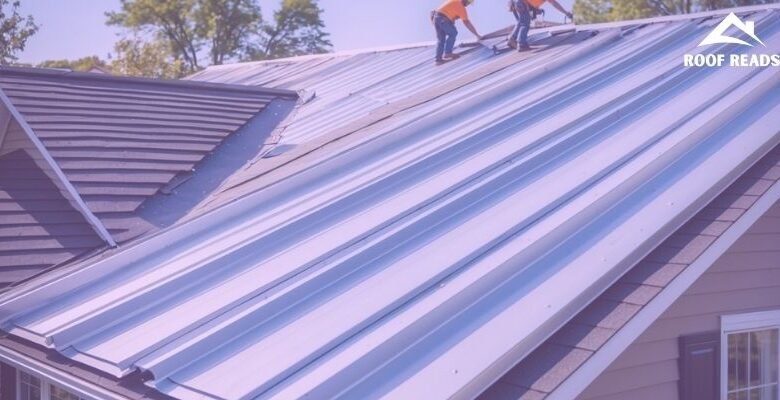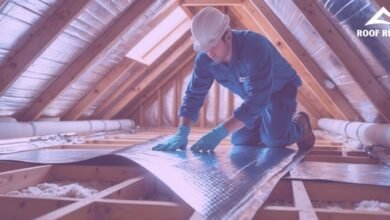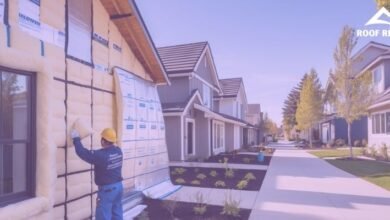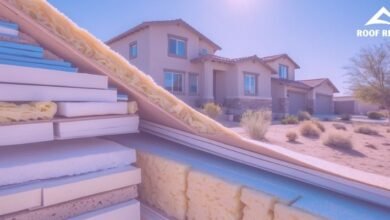Can You Put a Metal Roof Over Shingles: A Practical Guide to Roof Overlay

Thinking about a roof upgrade but dreading the mess and cost of tearing off your old shingles? You’re not alone. Many homeowners consider installing metal roofing directly over existing asphalt shingles as a potential solution to save time and money.
Yes, you can install a metal roof over existing shingles in many cases, which can save on labor costs and reduce landfill waste. This approach eliminates the need for a complete tear-off, making the installation process quicker and less disruptive. However, this option depends on several factors, including your local building codes, the condition of your current roof, and the specific type of metal roofing system you choose.
For smaller structures like sheds, this might be a DIY project. For homes, though, professional installation is typically recommended. Steel shingle systems often work better than standing seam metal when installing over asphalt, providing durability and energy efficiency while avoiding the complexity of a complete roof replacement.
Key Takeaways
- Installing metal roofing over shingles can save time and money by eliminating tear-off costs while providing improved durability.
- Local building codes and the condition of your existing roof will determine if this installation method is permitted for your home.
- Professional installation is recommended for residential properties, while steel shingle systems typically work better than standing seam options for over-shingle applications.
Can You Put a Metal Roof Over Shingles?

Yes, you can install metal roofing over existing asphalt shingles in many cases. This approach, known as “overlay” or “recover,” can save time and money compared to a complete roof tear-off.
Understanding Existing Roof Structures
Before installing a metal roof over shingles, it’s crucial to assess the current roof condition. A professional inspection is necessary to check for damaged areas, leaks, or structural issues.
Most building codes allow for up to two layers of roofing, but this varies by location. If your home already has multiple shingle layers, you may need to remove them first.
The weight of the new metal roofing plus existing shingles must be considered. Your roof structure needs to support this combined weight safely.
Look for signs of rot, sagging, or water damage in the roof deck. These problems should be fixed before adding more roofing material.
Benefits of Installing Metal Roofing Over Asphalt Shingles
Cost savings is a major advantage since you avoid tear-off expenses. This can reduce labor costs by 25-30% on your roofing project.
The existing shingle layer provides additional insulation, potentially improving energy efficiency in your home.
Metal roofing is extremely durable, lasting 40-70 years compared to asphalt’s 15-30 years. It’s also fire-resistant and can withstand harsh weather conditions.
Installation can be faster because there’s no need to remove and dispose of old shingles. This means less disruption to your daily life.
The environmental impact is reduced by keeping old shingles out of landfills.
Potential Challenges and Considerations
Proper installation techniques are essential. Many professionals recommend adding wooden battens or strips over the shingles to create a flat surface and air gap.
A thorough inspection of shingle condition is critical. Installing metal over damaged or deteriorating shingles can lead to problems later.
Ventilation must be carefully planned. The space between metal roofing and shingles needs proper airflow to prevent moisture buildup.
The finished roof height will be higher, which may affect trim, flashing, and gutter positioning. These elements will need adjustments.
Some metal roofing systems work better than others for overlay installations. Steel shingle systems often perform better than standing seam options when installing over asphalt.
Step-by-Step Installation Process

Installing a metal roof over existing shingles requires careful preparation and precise execution. Following these steps will ensure a durable installation that can last for decades while saving time and money on shingle removal.
Preparing the Existing Shingles
Begin by thoroughly inspecting the existing roof for damage. Replace any broken or missing shingles and repair soft spots in the decking. This creates a solid foundation for your metal roof.
Clear all debris from the roof surface using a broom or leaf blower. Trim any overhanging branches that could damage the new metal roof during storms.
Secure any loose shingles with roofing nails to create a flat, stable surface. If the shingles are curling excessively, consider installing wooden battens to create a more level plane.
Check local building codes to confirm how many layers of roofing are permitted. Most areas allow two layers, but some restrict to just one, which would require shingle removal first.
Underlayment and Decking Requirements
Install a synthetic underlayment over the existing shingles. This creates a moisture barrier and prevents condensation between the metal and shingles. Synthetic underlayments are preferred over traditional felt paper because they’re more durable and water-resistant.
Roll out the underlayment horizontally across the roof, starting at the bottom edge. Overlap each row by at least 6 inches and secure with cap nails every 8-12 inches.
Inspect the roof deck through the attic for signs of water damage or rot. Any compromised decking must be replaced before proceeding with the metal roof installation.
For areas with high humidity or temperature fluctuations, consider adding a layer of rigid insulation between the shingles and metal roofing to prevent condensation issues.
Installing the Metal Roof
Start by installing drip edge flashing along the eaves and rakes of the roof. This prevents water from getting underneath the metal panels.
Place the first metal panel at one corner of the roof, aligning it carefully with the edge. Use a chalk line to ensure straight installation across the roof.
Secure the panels with specialized roofing screws that include rubber washers to create a watertight seal. Place screws every 24 inches along the panel seams and 12 inches in the field of the panel.
Proper Screw Placement:
- Through the flat part of the panel, not the ribs
- Tight enough to compress the washer slightly
- Not so tight that the washer distorts
Overlap panels according to manufacturer specifications, typically 1-2 inches. Cut panels as needed using tin snips or a circular saw with a metal-cutting blade.
Trim and Batten Installation
Install battens if you’re using a batten-style metal roof system. Space wooden battens 24 inches apart across the roof surface, perpendicular to the intended direction of the metal panels.
Secure ridge caps along the peak of the roof after all panels are installed. Ridge caps cover the seam where panels meet at the top and prevent water intrusion.
Install trim pieces around edges, valleys, and penetrations like chimneys or vents. Apply butyl tape or sealant where trim meets the metal panels to create watertight connections.
For a professional finish, add foam closures between the metal panels and trim pieces. These fill gaps created by the panel profile and prevent insects or water from entering.
Check all fasteners one final time to ensure they’re properly secured. Add touch-up paint to any scratched areas or exposed screw heads to prevent rust and extend the life of your metal roof.
Building Codes, Warranties, and Professional Guidance

When installing a metal roof over existing shingles, there are important legal, financial, and quality considerations to address before starting your project. Understanding these factors will help ensure your new roof is compliant, protected, and properly installed.
Local Building Codes and Regulations
Building codes vary significantly by location and can directly impact your metal-over-shingles project. Most municipalities allow one layer of roofing material, but some permit two layers. Before starting, check with your local building department for specific requirements.
Some codes limit the number of roofing layers allowed on a structure due to weight concerns. Too much weight can strain your home’s structural support system.
Permits are typically required for roofing projects. Installing without proper permits can result in fines and may force you to remove the new roof to comply with regulations.
Many areas have specific requirements for roof decking, fasteners, and installation methods for metal roofing. These regulations exist to ensure safety standards are met.
Manufacturer’s Warranty and Roof Insurance
Metal roofing manufacturers often have specific installation requirements that must be followed to maintain warranty coverage. Some warranties may be voided if metal roofing is installed over existing shingles.
Always review warranty documentation before purchase. Look for terms regarding installation over existing materials and any conditions that might limit coverage.
Most metal roofing comes with longer warranties than traditional roofing—often 30-50 years—but improper installation can nullify these benefits.
Your homeowner’s insurance policy may also be affected. Some insurers offer discounts for metal roofing due to its durability and fire resistance, while others might require specific installation methods.
Document your installation with photos and keep all paperwork, including permits, warranty information, and contractor agreements.
Hiring a Qualified Roofing Contractor
Look for contractors with specific experience installing metal roofing over shingles. Ask for references from similar projects and photos of completed work.
Verify that potential contractors are licensed, bonded, and insured in your state. This protects you from liability and ensures they meet professional standards.
Professional roofers can assess your existing roof structure to determine if it can support the additional weight of metal roofing. This evaluation is crucial for safety.
Obtain multiple quotes to compare costs, materials, and installation approaches. The lowest bid isn’t always the best choice—focus on value and expertise.
Request a detailed contract that specifies materials, timeline, payment schedule, and cleanup responsibilities. A good contractor will also explain their process for addressing any issues that arise during installation.
Performance and Long-Term Benefits

Installing a metal roof over shingles offers significant advantages in performance that last for decades. Metal roofing systems deliver superior protection while potentially reducing energy costs and maintenance requirements.
Longevity and Durability
Metal roofs typically last 40-70 years, compared to asphalt shingles which may need replacement every 15-20 years. This extended lifespan makes metal an excellent long-term investment despite higher initial costs.
Most metal roofing materials can withstand extreme weather conditions including high winds (up to 140 mph), heavy snow loads, and hail. Unlike shingles, metal roofs don’t crack, curl, or gradually lose granules over time.
Steel roofs with proper protective coatings resist corrosion for decades. Many manufacturers offer warranties of 30-50 years, reflecting their confidence in the product’s durability.
Metal roofing maintains its appearance and structural integrity with minimal maintenance, typically requiring only occasional inspections and cleaning.
Energy Efficiency and Insulation
Metal roofs reflect solar radiation rather than absorbing it, potentially reducing cooling costs by 10-25% during summer months.
The airspace created between the original shingles and new metal roof forms an additional insulation layer, improving the home’s thermal performance year-round.
Many metal roofing products are ENERGY STAR® certified, qualifying homeowners for potential tax credits or utility rebates.
Cool-roof coatings applied to metal surfaces can further enhance energy efficiency by reflecting up to 85% of solar heat.
The energy savings from a metal roof installation can offset a significant portion of its cost over the roof’s lifetime.
Ventilation and Drainage Considerations
Proper ventilation between metal roofing and existing shingles is crucial to prevent moisture buildup and potential roof leaks.
Most professional installations include a moisture barrier and ventilation system that allows air circulation, preventing condensation that could lead to mold or rot.
Metal roofing’s smooth surface allows water to drain quickly, reducing the risk of leaks compared to aging shingles with compromised drainage paths.
Many metal roofing systems include integrated drainage channels that direct water away from vulnerable areas.
Installation should include proper flashing around chimneys, vents, and valleys to ensure water flows correctly off the roof without penetrating beneath the metal.
Adequate ridge vents and soffit ventilation help maintain proper airflow throughout the roofing system, extending the life of both the metal roof and underlying structure.
Cost Considerations and Material Choices
When installing a metal roof over shingles, understanding both material options and costs will help you make the best decision for your home. The right choices can lead to significant long-term savings despite higher initial investments.
Comparing Metal Roofing Materials
Metal roofing comes in several varieties, each with different price points and benefits. Steel panels typically cost $5-12 per square foot and offer excellent durability with proper coating. Aluminum costs slightly more at $7-15 per square foot but resists corrosion better in coastal areas.
Copper and zinc represent premium options at $15-30 per square foot. Though expensive, these materials can last 70+ years with minimal maintenance. They develop attractive patinas over time.
Standing seam systems cost more than corrugated panels but provide better waterproofing and a modern appearance. Metal shingles that mimic traditional roofing cost more but offer aesthetic advantages for homeowners concerned about neighborhood appearance.
Estimating Installation Costs and Savings
Installing metal over existing shingles typically costs 20-30% less than complete tear-offs. This re-roofing approach saves $1,000-4,000 on labor and disposal fees for an average home.
Additional savings come from:
- Reduced installation time (2-4 days vs 5-7 days)
- Lower labor costs due to simplified installation
- No landfill disposal fees for old shingles
- Potential insurance premium reductions
Metal roofs also provide long-term financial benefits through energy efficiency. The reflective surface can reduce cooling costs by 10-25% in summer months. Most metal roofing materials qualify for energy efficiency tax credits of up to $500.
Maintenance costs are minimal compared to asphalt shingles, which may need replacement after 15-20 years. This makes metal roofing more economical over a 30-50 year period despite higher upfront costs.
Frequently Asked Questions
Metal roof installation over existing shingles raises important questions about structural integrity, building codes, and cost implications. Homeowners considering this roofing option should understand several key factors before making a decision.
What are the potential issues with installing a metal roof over existing shingle roofing?
Installing metal roofing over shingles can trap moisture between layers, potentially causing wood rot and structural damage. The added weight may stress your home’s structure, especially with multiple shingle layers already in place.
Uneven surfaces from curled or damaged shingles can create installation problems and affect how the metal roof sits. This might lead to noise issues during rain or wind.
Heat retention between layers can reduce energy efficiency benefits that metal roofs typically provide. Existing roof problems like leaks or damage won’t be fixed by simply covering them with metal.
Is obtaining a permit necessary before placing a metal roof over existing shingle roofing?
Yes, most localities require permits for installing a metal roof over shingles. Building codes vary by location, with some areas allowing only one layer of roofing material while others permit two.
Some regions have specific requirements for roof ventilation, fire ratings, or wind resistance that must be met. Failure to obtain proper permits can lead to fines, removal requirements, or complications when selling your home.
Always check with your local building department before starting your project. Professional roofers can often help navigate the permit process.
What are the advantages and disadvantages of installing a metal roof over shingles?
Advantages include significant labor and disposal cost savings since tear-off isn’t required. The process is faster and less disruptive than complete roof replacement. Metal roofs provide an additional insulation layer, potentially improving energy efficiency.
Disadvantages include the inability to inspect and repair underlying roof deck issues. The finished roof height will be higher, which may cause flashing and trim complications. Some warranties may be voided when metal is installed over shingles.
The added weight can stress your home’s structure, especially in areas with heavy snow loads. Future roof replacement becomes more complicated and expensive when multiple layers exist.
Is an underlayment required when installing a metal roof over shingles?
Yes, a proper underlayment is crucial when installing metal roofing over shingles. It creates a moisture barrier that prevents condensation from damaging the roof structure.
Common underlayment options include synthetic materials or special breathable membranes. These help reduce noise transmission and provide a smoother surface for metal panel installation.
Building codes typically require underlayment for all roofing installations. Skipping this step risks voiding manufacturer warranties and may lead to premature roof failure.
Can installing a metal roof directly over shingles cause condensation problems?
Condensation can occur when warm, moist air from your home meets the cooler underside of metal roofing. This risk increases when proper ventilation and vapor barriers aren’t installed.
Using furring strips or battens creates an air gap that reduces condensation potential. Proper attic ventilation is essential to prevent moisture buildup between the roofing layers.
Breathable underlayment materials help manage moisture migration. Professional installation with attention to ventilation details significantly reduces condensation risks.
How does the cost of installing a metal roof over shingles compare to other roofing methods?
Installing metal over existing shingles typically costs 15-25% less than complete roof replacement. Labor savings come from eliminating tear-off, disposal fees, and reduced installation time.
Long-term costs favor metal roofing due to its 40-70 year lifespan compared to asphalt’s 15-30 years. Energy savings from metal’s reflective properties can reduce cooling costs by 10-25% in warm climates.
Initial material costs for metal roofing are higher than asphalt shingles. However, when factoring in longevity, reduced maintenance, and potential insurance discounts, metal roofing often provides better lifetime value.




